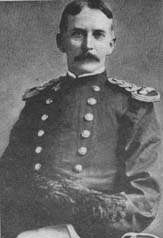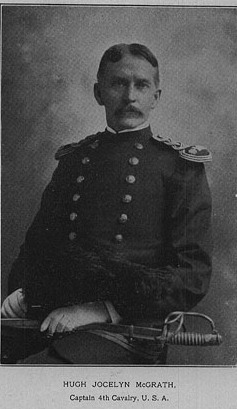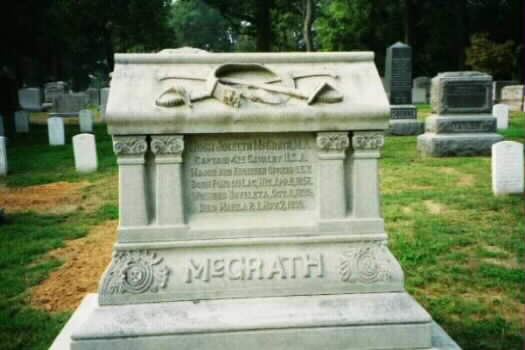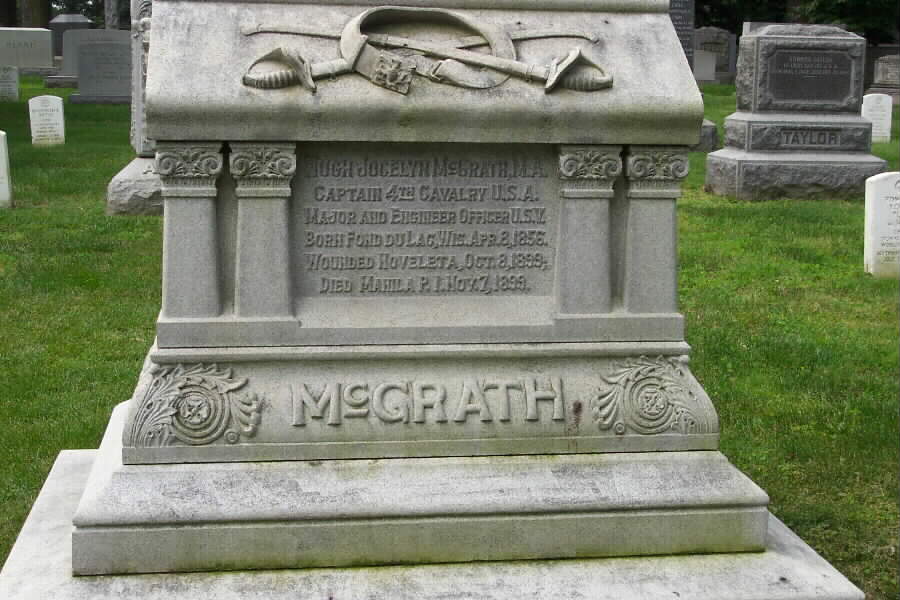Born at Fond du Lac, Wisconsin, on April 8, 1858, he entered the service at Eau Claire, Wisconsin. He was awarded the Medal of Honor while serving as Captain, 4th United States Cavalry at Calambam, Luzon, Philippines Islands on July 26, 1898 during the Insurrection there. The Medal was officially conferred on April 29, 1902.
His stone in Section 1 of Arlington National Cemetery reads: “Captain, 4th Cavalry, USA, Major and Engineer Officer, U.S. Volunteers. Wounded at Boveleta, Philippine Islands, October 8, 1899, and died at Manila, Philippine Islands, November 7, 1899.
Hugh Joslyn McGrath of Wisconsin
- Appointed from Wisconsin, Cadet, United States Military Academy, 14 June 1876 Commissioned Second Lieutenant, 4th United States Calvary, 12 June 1880
- First Lieutenant, 26 May 1886
- Captain, 19 June 1897
- Major, Engineers Office of Volunteers, 20 June 1898 to 12 May 1899
- Awarded the Medal of Honor 7 February 1902 for most distinguished gallantry at Calamba, Luzon, Philippine Islands, 26 July 1899 in swimming the San Juan River in the face of the enemy’s fire and driving him from his entrenchment’s
- Died 7 November 1899 of wounds received 8 October 1899 in action at Noveleta, Philippine Islands
SKETCH OF CAPTAIN MCGRATH
Private and Military Career of Wisconsin Soldier
Who Distinguished Himself Near Manila
EAU CLAIRE, Wisconsin – July 28, 1899 – Captain Hugh Jocelyn McGrath, whose gallantry in the recent engagement south of Manila has brought him into notice as one of the heroes of the war, was born in April 1856 at Fond du Lac, Wisconsin, and moved to Eau Claire with his parents in 1859. He was educated in the public schools of Eau Claire and the University of Wisconsin and graduated from the West Point Academy.
He was assigned to the Fourth Cavalry and began his service at Fort Reno. He served in New Mexico and Arizona and was engaged in campaigns against Geronimo and other Apache chiefs. He spent two years at the Leavenworth Cavalry and Infantry School and for three years was instructor in military science at Wisconsin University.
When the Spanish War began he was at Vancouver Barracks and asked for active duty, was made Major of Engineers in the Volunteers, service at Jacksonville and Savannah and later at Havana. When the Seventh Corps was disbanded he was ordered to Manila and reached there June 30 and was in a brush with insurgents soon after his arrival.
Captain McGrath marries Miss Mary Carson of Eau Claire at Savannah last October. She is the daughter of the late lumber manufacturer, William Carson. Captain McGrath’s first wife was a daughter of General Blain. One child, a son, was the offspring of their union.
MAJOR MCGRATH IS DEAD
Hero of Calamba Succumbs To Injuries At Manila
Wisconsin Man Who Was Captain In The Fourth Cavalry
Dies Of Wounds Received At The Battle of Novaleta
Burial Will Be At Eau Claire
Dean C. Worcester’s Tribute To The Bravery Of
The Soldier – His Military Record
Washington, D.C. – November 8, 1899 – A cable message from General Otis this afternoon says that Major Hugh J. McGrath (Captain, Fourth Cavalry) died at Manila yesterday from wounds received at the battle of Novaleta a month ago. Major McGrath was appointed to the Military Academy from Wisconsin.
Eau Claire, Wisconsin – November 8, 1899 – News of the death of Captain Hugh Jocelyn McGrath was received here this morning, together with the statement that the body will be shipped on the transport Zealandia on November 10. Burial will be in Eau Claire.
Captain McGrath, who had a record for bravery, was wounded during a movement to clear the country between Bacoor and Imus. A brass cannon loaded with scrap iron was discharged by the insurgents and an iron nut struck Captain McGrath in the thigh. Death is supposed to have been due from complications. He was taken after the battle to a hospital in Manila and cabled to his wife: “Wounded left thigh. Don’t worry.”
Captain McGrath was born on April 8, 1856 in Fond du Lac, Wisconsin, and came with his parents to Do Eau Claire in 1859. The young man was educated in the public schools of Eau Claire and the University of Wisconsin. In 1876 he was admitted to the West Point Academy and was graduated in 1880. He joined his regiment, the Fourth Cavalry, the following September at Fort Reno and spent two years at the Infantry and Cavalry School at Fort Leavenworth, Kansas. He was an instructor in military science at Wisconsin University for three years.
Captain McGrath served in New Mexico and Arizona against Geronimo and the other Apache chiefs, and later was stationed at Walla Walla, Washington. He was a Vancouver Barracks when the Spanish War opened. He asked for active duty and was made Major in the Volunteer Engineers and sent to Jacksonville, Florida, where he served in the Seventh Corps, later going to Havana, where he remained until the Corps was disbanded.
Captain McGrath left San Francisco for Manila on May 25 to rejoin the Fourth Cavalry and arrived there about June 30.
Captain McGrath was married at Savannah, Georgia, on November of last year to Miss Mary Carson of Eau Claire. A son has been born to them.
Professor Dean Worcester, member of the Philippine Commission, in an interview on October 20 last, declared that Major (then Captain) McGrath was one of the greatest heroes in the Philippines.
“It was a Calamba,” said Professor Worcester,” and important town in Laguna de Bay, that was taken by Lawton. While the troops were in front of this town and in the face of a hot a furious fire from the Filipinos it was found necessary to cross a stream that was swelled with recent rains until it was most difficult to get over. There were neither boats nor rafts, but on the opposite side and directly under the rifles of the Filipinos were two canoes.
“At that juncture, the hero revealed himself in the person of Captain McGrath of the Fourth Cavalry. He did not wait for orders, nor did he call for volunteers. He stripped and plunged into the whirling stream and came back in half an hour with two canoes. There were some bullet holes in the canoes by the time he got across with them, but they were made to serve the purpose of transporting a storming party across the stream and the trench was taken.
“It was the most daring thing I ever witnessed, and I believe that most daring action that has come to my attention.”
McGRATH, HUGH J.
Rank and organization: Captain, 4th U.S. Cavalry. Place and date: At Calamba, Luzon, Philippine Islands, 26 July 1899. Entered service at: Eau Claire, Wisconsin. Birth: Fond du Lac, Wisconsin. Date of issue: 29 April 1902.
Citation:
Swam the San Juan River in the face of the enemy’s fire and drove him from his entrenchments.
MCGRATH, HUGH J
- CAPT 4TH REGT US CAV
- VETERAN SERVICE DATES: Unknown
- DATE OF DEATH: 11/07/1899
- DATE OF INTERMENT: Unknown
- BURIED AT: SECTION EAST SITE 315
- ARLINGTON NATIONAL CEMETERY
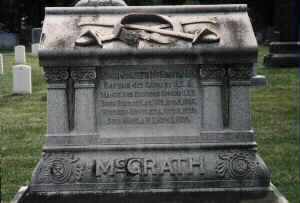
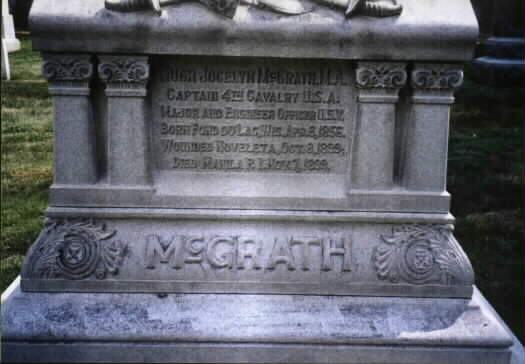
MCGRATH, HUGH J
- CAPT 4TH REGT US CAV
- DATE OF DEATH: 11/07/1899
- BURIED AT: SECTION 1 (EAST) SITE 315
- ARLINGTON NATIONAL CEMETERY
Michael Robert Patterson was born in Arlington and is the son of a former officer of the US Army. So it was no wonder that sooner or later his interests drew him to American history and especially to American military history. Many of his articles can be found on renowned portals like the New York Times, Washingtonpost or Wikipedia.
Reviewed by: Michael Howard

